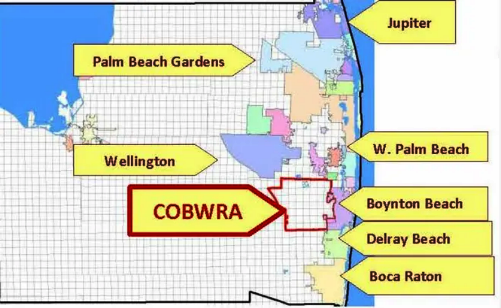|
Article Courtesy of The Palm
Beach Post
By Mike Diamond
Published May 3, 2023
|
A
rare revolt has broken out at the Coalition of Boynton West Residential
Associations (COBWRA) with four Ag Reserve Communities — Canyon Lakes, Canyon
Isles, Canyon Springs and Canyon Trails — withdrawing from the 41-year old
organization that monitors development in the region.
|
Tensions between COBWRA and several Ag Reserve communities have been brewing for
some time. Upset over some of COBWRA's positions, the Ag Reserve communities
last year created their own working group, the Boynton Ag Reserve Communities (BARC),
to review development plans in the Ag Reserve, a 20,923-acre region with special
zoning to limit residential and commercial density to protect farming. The area
is west of Boynton Beach, Delray Beach and Boca Raton.
BARC consists of 10 Ag Reserve communities but until last week, they were all
also part of COBWRA. At issue is COBWRA's "line-in-the-sand" policy that opposes
buildings of four or more stories. BARC members are willing to accept the taller
buildings in exchange for plans that keep buildings farther away from
residences.
Developers are looking to build projects
with anticipated value of more than $1 billion at the
corners of Acme Dairy Road and Boynton Beach Boulevard that
are expected to include restaurants, a storage facility,
indoor pickleball courts, a congregate living facility and
workforce and affordable housing. |
|
COBWRA region covers much more than the Ag Reserve.
It consists of HOAs that, for the most part, are west of the
Turnpike and west of Boynton Beach, Delray Beach and Boca Raton.
|
"We made it clear to COBWRA how we felt and they ignored us," said Ryan
Anderson, president of the Canyon Trails HOA. "COBWRA is just not
representing us. We feel ignored." Other communities may be withdrawing as
well, according to Anderson.
The development planned for the southeast corner of Acme Dairy Road and
Boynton Beach Boulevard would abut Canyon Trails.
"We want it to be as far away as possible and in exchange for allowing
four-story buildings, we would get a set back of 835 feet," Anderson said.
"That is huge for us."
COBWRA president: Defecting communities are 'making a big mistake'
COBWRA President Steve Wallace said he wishes the Canyon communities the best of
luck but believes "they are making a big mistake by going on their own. They are
stronger with us than without us. This was a power play by certain members of
the Canyon communities. We have developed a very strong relationship with county
commissioners. You build that over time."
COBWRA argues that four-story buildings would be out of character in the Ag
Reserve. Wallace noted that COBWRA has always advocated for nothing more than
three stories and has been very clear about that.
Mryna Rosoff, who served as COBWRA's president from 2013-2016 and from
2017-2018, said the three-story limit is now more important than ever with Gov.
Ron DeSantis recently signing into law "The Live Local Act."
The law takes away the review power of local officials over development
proposals involving workforce and affordable housing projects. Such developments
are entitled to be built to the same height of any building within a one-mile
radius.
"This could open up the floodgates to very dense development," Rosoff said.
"Once you go to four stories, there is no stopping it."
The relationship between the two groups is so strained that Wallace threatened
to sue Craig Ditman of Canyon Trails, a BARC member, for defamation. Wallace was
upset with an email Ditman sent to BARC members claiming that COBWRA pushed for
a design change that was unacceptable to Canyon Trails. Ditman also said the
change was done without first consulting the community.
Ditman, an architect, said in his email to BARC members that COBWRA withdrew an
offer to have him serve as a COBWRA director for another year for complaining
about COBWRA policies. He opposed the COBWRA design because he said it "will
forever change our quality of life." Wallace said Ditman's email contained
claims that were "patently false."
Neither Ditman nor Wallace would comment on the threatened litigation. And
Ditman declined to comment at all on the dispute between COBWRA and BARC.
But in an email to Ditman, Wallace said, "Craig, congratulations. Your last
response has met all the elements of prima facie defamation per se. My attorney
is copied on this email. Expect a demand letter forthcoming. To aid in the
process, please provide us a copy of your homeowners insurance policy."
The only other time in recent years that a community withdrew from COBWRA was in
2016 when Canyon Lakes pulled out. It rejoined and now has again withdrew along
with the other Canyon communities.
Height issue of future development a sticking point in dispute
Steven Sculler, president at Canyon Isles, questioned why COBWRA refuses to
compromise on the height issue as the Canyon communities will be most impacted
by the soon-to-come west-of-the Turnpike developments.
"The new middle school being built will be taller than three stories so we don’t
understand why this is an issue.
A four-story building would really not be out of place."
As for the future, Sculler said Canyon Isles would consider rejoining but added:
"We don’t want to be ignored."
Neil Ambrosio, a founding member of BARC and a board member at Canyon Lakes,
said BARC has been highly effective and collaborative in dealing with
development issues in the region, adding: "Canyon Lakes has been fortunate to
build strong relationships with our district commissioner and staff, as well as
other county officials in various departments within the county."
In its withdrawal letter to COBWRA, Canyon Lakes said it “cannot afford to have
our positions filtered” in favor of the personal views of leadership and its
committees. We believe we can most effectively advocate for our residents by
direct relationships with our elected county representatives and other
stakeholders, in concert with our neighboring Agricultural Reserve communities.”
|
